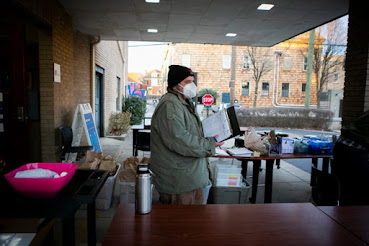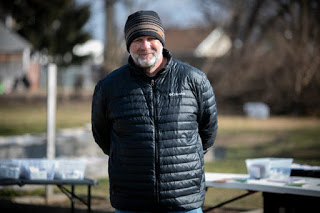“The people who care: How harm reduction strategies for those who use drugs bloomed in the region,” Terry DeMio of the
tells the story of several people, including Kentuckians, who have benefited from such programs and the value of those who work in them.
One of DeMio’s stories involves a nurse, Daryl Hams, who is the project director of the Regional Harm Reduction Collaborative, and how he carried wound-care supplies with him for three weeks in hopes of reconnecting with a man with a “festering abscess,” for whom he had already provided supplies once and whom he urged to get and take his antibiotics. He finally ran in to him at a naloxone-giveaway site and told him he had been worried about him.
DeMio writes: “The man proudly showed off a wrist no longer bandaged, the abscess healed. He started to walk away. Then stopped and turned back. “It’s been a long time,” the man said, “since anybody worried about me.”
Another story involves Molly B. True, 41, of Bellevue, Ky., who started using heroin in the late 1990s and told DeMio that she always tried to use safely, but it was hard. And that while she knew there were places across the country where people could get sterile syringes, without judgement, “I remember thinking, ‘Gosh, that’ll never happen in Cincinnati’,” she said.
DeMio writes that in the late 1990s through the early 2000s, people who used intravenous drugs were on their own — but not today because “there are Daryls” and there is finally an understanding that addiction is a health issue that can’t be solved by locking people up in jail.
“It has taken Greater Cincinnati something like two decades to understand what Daryl and people like him offer,” she writes. “It’s called ‘harm reduction,’ a host of strategies to minimize negative physical and social outcomes from drug use. It’s that place between prevention and treatment, where people who use drugs simply are.”
DeMio also writes about the pushback such programs have received and the evolution of how they have come to exist, largely driven by the rising numbers of hepatitis C cases and the rising number of needles being found in public areas.
“The hepatitis C virus can live in the barrel of a syringe for up to six weeks. People started to realize they, or their children, could get the bloodborne disease,” she writes.
Dr. Judith Feinberg, an infectious disease expert who at the time was a professor at the University of Cincinnati College of Medicine, is the pioneer of harm reduction in Cincinnati.
Feinberg started gathering research to support the program in 2006 and was finally successful in opening it in 2014, DeMio reports, adding that Feinberg’s analysis showed “what newer studies amplify: Syringe services have been associated with a 50% reduction in HIV and hepatitis C.”
Further, DeMio reports that such programs cost less than $2 a day per person.
“Compare that to the lifetime cost of HIV treatment which is about $350,000 per person. The annual cost of hepatitis C treatment? About $84,000 per patient,” she writes.
In addition, Feinberg cites research from the Centers for Disease Control and Prevention that says “people who use drugs are five times more likely to enter treatment.”
Feinberg told DeMio that these programs not only provide a place to get things, like sterile syringes, drug-cooking devices, alcohol wipes, naloxone, HIV and hepatitis C testing and condoms, but are also meant to offer a supportive environment that treats people with dignity.
“You have a totally supportive, nonjudgmental rapport so that if, or when, they are ready (for treatment), you are there,” she said.
 |
Billy Golden, a harm-reduction coordinator at Caracole, works at a drive-up
syringe exchange. (Cincinnati Enquirer photo by Amanda Rossmann) |
For a woman named Molly, that support had a name: Billy Golden, a harm-reduction coordinator at Caracole in Cincinnati, who told DeMio about the importance of making the exchange a safe space for people who use drugs.
If a client was there for three minutes, Billy says he made sure, “for three minutes of the day, that person was more than their drug addiction.”
Billy helped Molly get a doctor who understood addiction, DeMio reports, adding that Molly has been in methadone treatment since September and manages her drug use, using maybe twice a week instead of what used to be several times a day.
“My life is exponentially better,” Molly says. “I am a different person. I buy Christmas presents. I have a bed now. . . . My ultimate goal [is] to continue to volunteer, and maybe it will lead to some actual, real job in harm reduction. I feel like that’s where I belong.”
In mid-January, Molly was unanimously appointed to the Harm Reduction Ohio board of directors, which DeMio writes “is indicative of another pillar that the National Harm Reduction Coalition advocates: Ensuring that people who use drugs and those with a history of drug use routinely have “a real voice” in programming and policy designed to serve them.”

